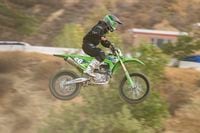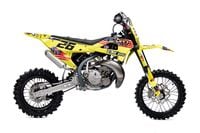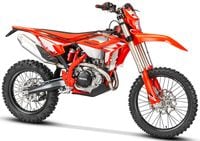Behind every great rider is a great mechanic. That's obvious in racing, but also true in testing.The Dirt Rider 24 Hour Torture Test is definitely a test, but doesn't carry with it the same pressures of a full blown shootout. An event like this one brings out every level of rider from the guy in a pick-up truck, to the factory big rigs. It is very apparent that the top riders have a staff of people making it possible for them to be there. We sat down with Eric Crippa in Honda's "Fun Mover" to get the mechanic's perspective on this wild time in the mountains, and to get acquainted with this veteran mechanic.DR: What's the Dirt Rider 24 Hour event like from the Mechanic's point of view?EC: It's a fun event. It is not a super high-pressure event like a shootout is. Instead, it gives us a chance to see people and have some fun. All the industry is here. I see people here that I've known for 30 years. That's really cool. It's fun to exchange cards with people "in the know", and learn new things. We are always learning. We find out about new products, and how things work. Also of course, I get a chance to ride, which is great.DR: Have you ridden yet this week?EC: Yep, yesterday I did a loop, and I'll do more tomorrow.DR: What's the preparation like for the Dirt Rider 24 Hour Torture Test?EC: Well, the prep on the bike is simple because of the nature of testing a nearly stock bike. Karel wanted to make all the stock bikes fair with the same silencer and spark arrestor. We jetted the bike a little bit differently, but not a lot. We also opened the air box up a little bit. This doesn't affect noise that much, but does give you better performance. We opened up the top of the air box. Usually the CRX has a more closed off top to the box. We made it a little bit more like a motocross bike. This does affect the noise a little bit, but nothing like the increase from modifying the exhaust. All these modifications will work with the standard exhaust with the noise baffle in place, and will work with the same jetting. So we didn't have to do a ton of work on prepping bikes. We put in some time on the creature comforts of being here. Ray Conway and I knew it was going to be cold, so we wanted to have the right clothes, fuel for warmth, and enough food.DR: It sounds like you have spent some time being too cold. Does anything particular come to mind?EC: Yes, as a matter of fact I did spend the night out here in these hills once, all night long in just a jersey, in the snow. I think it was zero, I'm not kidding. We were out riding, and we ran out of daylight. We were only about fifteen minutes from the truck, but it was pitch black! I mean dark. We got a fire going about 8 o'clock, and that saved our lives. We found out later that 2 guys died the weekend before, they froze to death.DR: You have been in the industry since 1965. What was your first bike, and where did that take you?EC: My first bike was a Honda Trail 90, then a Yamaha 80. My dad said he would buy me my first bike if I worked for him doing some odd jobs that summer. I was 14 years old and Dad was starting one of the first Cable TV business in the world. I was to run the cables in through the attics and down into the house from there. "It'll be easy", he told me. What he didn't tell me was that it would be 160 degrees in the attics of the homes I would be working above, and all of them had blown fiberglass. I was itchy for a month, and I had to sell the service door to door. So I was one of the first Cable Guy's, but I did get a bike at the end of that summer, the Honda Trail 90. My first lesson about being a mechanic I learned on that bike. There was a terrible rattle, so I thought I would just hold the heat shield on the exhaust pipe while I was riding it, to see if that was the source of the rattle. Oh brother, kids do stupid things. Once on that bike I rode through a John Wayne movie while they were shooting near my house. We lived out in the country near Thousand Oaks on a 11 acre horse ranch. I started racing in '65 and won almost every race I entered for 4 or 5 years. Some of them were motocross, but I also did Scrambles, TT races, and desert too. Then I became a pro motorcycle mechanic in 1973 for Husqvarna under Gunnar Lindstrom. I won a championship wrenching for Kent Howerton with Husqvarna during that time, and also won a few 2nds. Then in 1979, Gunner hired me again for Honda. That was the year that Chuck Sun won the 500cc Championship and got 2nd in Supercross, that was a good year for my bikes. In fact, that really started Honda's winning streak that lasted about 15 years. I worked with the race team and Roger DeCoster from 1984-1989, testing bikes. I was the mechanic, and he was the rider. We would try stuff, and come up with settings, then take it to the riders. At that time it was Hannah, Johnson, and O'Mara that would race what we prep'ed. That system worked great. In 1989 I went over into Production Testing, and the Press department. With all the many models that Honda has, I have concentrated more on press intro's. I do the planning and set-up the press intros for watercraft, street bikes, ATVs, motocross, and offroad.DR: Who's on the list of Pro Riders that you have wrenched for?EC: Bob Grossey, Gary Semics, Kent Howerton, Brad Lackey, Chuck Sun, Magoo Chandler, Steve Morton. I did motors for Micky Dymond when he won the Motocross Des Nations overall on a 125. I also did motors for Rick Johnson and Bob Hannah. After that, I went into production testing as I mentioned before.I'm sure our sport has progressed greatly as a direct result of the hard work of Eric Crippa. He has installed, tweeked, fixed, mended, and tuned his way through the golden age of motocross. Thanks Eric for always striving to make the bikes better.
Latest
/cloudfront-us-east-1.images.arcpublishing.com/octane/MD6XTZRDSJCM3HUCS7BNL6RCVM.jpg)
/cloudfront-us-east-1.images.arcpublishing.com/octane/4CJ2PHHAEFAARDER2HBICCITXE.jpg)


/cloudfront-us-east-1.images.arcpublishing.com/octane/4M2SRDUFDZF6XFPZL7IYESHDC4.jpg)
/cloudfront-us-east-1.images.arcpublishing.com/octane/JMCDU47IXNAABEK3HT7255TFSU.jpg)

/cloudfront-us-east-1.images.arcpublishing.com/octane/ETCSEDWJV5BGXGHEZFINNZGLMA.jpg)
/cloudfront-us-east-1.images.arcpublishing.com/octane/MD56OW3SRRCBJFWV5F36BOZYUE.jpg)
/cloudfront-us-east-1.images.arcpublishing.com/octane/D3GB6FLJVVDDVCJPJR3ZG276DI.jpg)
/cloudfront-us-east-1.images.arcpublishing.com/octane/PXDBJAHBNFHIPIII2RETRYIHV4.jpg)
/cloudfront-us-east-1.images.arcpublishing.com/octane/IP7MOVDXWFCGJH5HQHH4T44UJI.jpg)
/cloudfront-us-east-1.images.arcpublishing.com/octane/Y4EZFRIEQRE7ZFINGRA2ONFGGQ.jpg)
/cloudfront-us-east-1.images.arcpublishing.com/octane/UIVE2WGHJRCGNLMDXYO2YR27PA.jpg)
/cloudfront-us-east-1.images.arcpublishing.com/octane/XVCN7KNMTFDHZMKMCH5DU5YZRU.jpg)
/cloudfront-us-east-1.images.arcpublishing.com/octane/DTPGQUZAIZAZNPRXG4V6QATIVM.jpg)
/cloudfront-us-east-1.images.arcpublishing.com/octane/Y7EYU3ZTTJFLZEA75REMWWBLSQ.jpg)
/cloudfront-us-east-1.images.arcpublishing.com/octane/TGSYZNI7UVEI7K7ULLVVQ324A4.jpg)
/cloudfront-us-east-1.images.arcpublishing.com/octane/XGKGRRHXPNDRBGPCV4FUAARLRE.jpg)
/cloudfront-us-east-1.images.arcpublishing.com/octane/4MNSJWN6UFEMTDQHVLM52C3X44.jpg)
/cloudfront-us-east-1.images.arcpublishing.com/octane/U6X2X4HGPNCYTNMPYOAN4IIJ5Q.jpg)
/cloudfront-us-east-1.images.arcpublishing.com/octane/B6ZIPVYSKVA3LHDJTGAEEMN4VM.jpg)
/cloudfront-us-east-1.images.arcpublishing.com/octane/I24MVSJBNZDALNIYUHHPVFWNZM.jpg)
/cloudfront-us-east-1.images.arcpublishing.com/octane/SIAXQ2ZOPNBYBLPKJPCHIYGG6A.jpg)